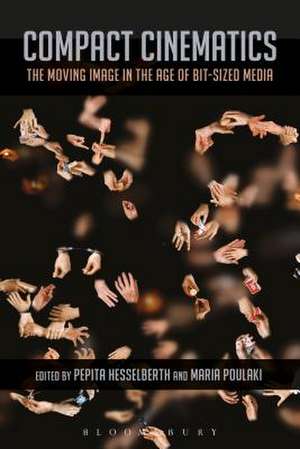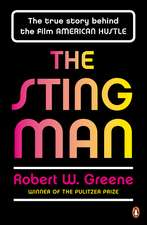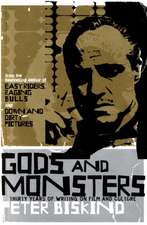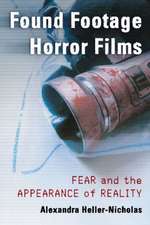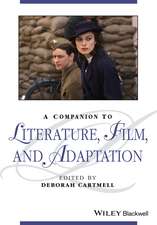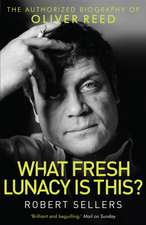Compact Cinematics: The Moving Image in the Age of Bit-Sized Media
Editat de Pepita Hesselberth, Maria Poulakien Limba Engleză Paperback – 25 iul 2018
| Toate formatele și edițiile | Preț | Express |
|---|---|---|
| Paperback (1) | 237.37 lei 6-8 săpt. | |
| Bloomsbury Publishing – 25 iul 2018 | 237.37 lei 6-8 săpt. | |
| Hardback (1) | 774.53 lei 6-8 săpt. | |
| Bloomsbury Publishing – 25 ian 2017 | 774.53 lei 6-8 săpt. |
Preț: 237.37 lei
Preț vechi: 305.56 lei
-22% Nou
Puncte Express: 356
Preț estimativ în valută:
45.43€ • 49.33$ • 38.16£
45.43€ • 49.33$ • 38.16£
Carte tipărită la comandă
Livrare economică 22 aprilie-06 mai
Preluare comenzi: 021 569.72.76
Specificații
ISBN-13: 9781501343933
ISBN-10: 1501343939
Pagini: 256
Ilustrații: 50 bw illus
Dimensiuni: 152 x 229 mm
Greutate: 0.35 kg
Ediția:NIPPOD
Editura: Bloomsbury Publishing
Colecția Bloomsbury Academic
Locul publicării:New York, United States
ISBN-10: 1501343939
Pagini: 256
Ilustrații: 50 bw illus
Dimensiuni: 152 x 229 mm
Greutate: 0.35 kg
Ediția:NIPPOD
Editura: Bloomsbury Publishing
Colecția Bloomsbury Academic
Locul publicării:New York, United States
Caracteristici
Introduces
the
new
concept
of
compactness,
and
offers
a
concrete
media
theoretical,
analytical,
and
archaeological
perspective
from
which
to
rethink
contemporary
cinematics
and
its
significance
within
our
present-day
media-saturated
culture
Notă biografică
Pepita
Hesselberthis
assistant
professor
in
cultural
theory,
film,
and
digital
media
at
the
Department
of
Film
and
Literary
Studies,
Leiden
University,
the
Netherlands.
She
is
the
author
ofCinematic
Chronotopes(Bloomsbury,
2014),
and
the
guest
editor
ofEmpedocles:
Journal
of
Philosophy
of
Communication,
on
"Short
Film
Experience"
(with
Carlos
Roos;
2015).
Currently
she
is
working
on
her
project
onDisconnectivity
in
the
Digital
Age,for
which
she
received
a
grant
from
the
Danish
Council
of
Independent
Research,
and
is
appointed
as
a
research
fellow
at
the
University
of
Copenhagen.Maria
Poulakiis
Lecturer
in
Film
and
Digital
Media
Arts
at
University
of
Surrey,
UK.
Placing
contemporary
cinematics
within
the
realm
of
complexity
theory
and
neuroscience
debates
she
has
contributed
toScreen,New
Review
of
Film
and
Television
Studies,Film-Philosophy,Cinema
&
Cie,Projections,
and
a
number
of
edited
volumes.
Cuprins
IntroductionCompact
Cinematics:
Screen,
Capture,
Attention
//
Pepita
Hesselberth(Leiden
University,
The
Netherlands)&
Maria
Poulaki(University
of
Surrey,
UK)Part
1
[Short]
Minimal
Narratives1.
Countdown
to
Zero:
Compressing
Cinema
Time
//
Tom
Gunning(The
University
of
Chicago,
US)2.
On
Conflict
in
Short
Film
Storytelling
//
Richard
Raskin(Aarhus
University,
Denmark)3.
Accelerated
Gestures:
Play
Time
in
Agnès
Varda'sCléo
de
5
à
7//
Peter
Verstraten(Leiden
University,
The
Netherlands)4.
Lynch
on
the
Run:
The
Proximity
of
Trauma
in
the
Short
Film
//
Todd
McGowan(The
University
of
Vermont,
USA)Part
2
[Condensed]
Polyphonic
Archives5.
The
Ethics
of
Repair:
Re-Animating
the
Archive
//
Sean
Cubitt(Goldsmiths,
University
of
London,
UK)6.
Long
Story
Short
//
Natalie
Bookchin(Rutgers,
USA)7.
Skip
Intro?
Short
Video
Intros
as
a
Reflexive
Threshold
in
the
Interactive
Documentary//
Tina
M.
Bastajian(Webster
University
the
Netherlands,
The
Netherlands)8.
The
Viewser
as
Curator:
The
Online
Film
Festival
Platform
//
Geli
Mademli(University
of
Amsterdam,
The
Netherlands)Part
3
[Compressed]
Pleasure
&
Productivity9.
The
Contingent
Spectator
//
Francesco
Casetti(Yale
University,
USA)10.
Speed
Watching,
Efficiency,
and
the
New
Temporalities
of
Digital
Spectatorship
//
Neta
Alexander(The
New
York
University
Tisch
School
of
the
Arts,
USA)11.
Visual
Pleasure
and
GIFs
//
Anna
McCarthy(The
New
York
University
Tisch
School
of
the
Arts,
USA)12.
Solitary
Screens:
On
the
Recurrence
and
Consumption
of
Images
//
Pasi
Väliaho(Goldsmiths,
University
of
London,
UK)Part
4
[Miniature]
Mobile
Cinematics13.
Archaeology
of
Mobile
Film:
Blink,
Bluvend
and
the
Pocket
Short
//
Kim
Louise
Walden(University
of
Hertfordshire,
UK)14.
Children's
Little
Thumb
Films
or
"Films-Poucets"
//
Wanda
Strauven(Goethe-Universität
Frankfurt,
Germany)and
Alexandra
Schneider(University
in
Mainz,
Germany)15.
Of
Flip
Books
&
Funny
Animals:
Chris
Ware'sQuimby
the
Mouse//
Yasco
Horsman(Leiden
University,
The
Netherlands)16.
Mobile
Cinematics
//
Maria
Engberg(Malmö
University,
Sweden)and
Jay
David
Bolter(Georgia
Institute
of
Technology,
USA)Part
5
[Compacted]
Urban
Ecologies17.
Screening
Smart
Cities:
Managing
Data,
Views,
and
Vertigo
//
Gillian
Rose(The
Open
University,
UK)18.
Of
Compactness:
Life
with
Media
Façade
Screens
//
Ulrik
Ekman(University
of
Copenhagen,
Denmark)19.
Codified
Space:
Cinematic
Recodings
of
Urban
Reality
//
Justin
Ascott(Norwich
University
of
the
Arts,
UK)
Recenzii
[T]he
book
features
excellent
articles
of
interest
to
scholars
working
on
specific
aspects
of
screen
and
visual
cultures.
[T]he book's attention to the generally neglected ecology of short-form work that is so prevalent today, along with its insistence on a broad historical context that refuses to neglect the past as we examine the present and look to the future, make it vital; (.) the attempts to name and frame a shifting context underscore how complex the changes are.
Compact Cinematicsis a rich well of provocative thought on both media and its role in our lives, historically and presently ... A stimulating text and, read in whole, it will not fail to ignite passion for further research in nearly everyone who reads it ... Those interested in the topic at every level would benefit from this text.
A necessary read for media and moving image scholars and practitioners.
Hesselberth and Poulaki have assembled some of the most exciting thinkers in the field, with essays both from emerging and established voices, to rethink the concepts of compactness, fragmentation and the short in visual culture. The result is an extremely rich collection, spanning film, television and digital media studies, and one that offers ways new ways to think through the compression of twenty-first century media.
Compact Cinematicsis a bold collection of essays by leading film and media theorists who depart from the notion of object-oriented study, refocusing debate around processes, habits and textures. The range of approaches delivers a fittingly multi-angled view of the current mediascape in which intensity resides in the miniature and the fragment, images are both commanding and adhesive, and human attention is a premium capture.
Compact Cinematics: The Moving Image in the Age of Bit-Sized Mediais a stimulating text and, read in whole, it will not fail to ignite passion for further research in nearly everyone who reads it. The text's own exploration of what 'compact cinema' entails, expounded on in seven of the chapters, is enlightening to consider and expands our view of contemporary media.
[T]he book's attention to the generally neglected ecology of short-form work that is so prevalent today, along with its insistence on a broad historical context that refuses to neglect the past as we examine the present and look to the future, make it vital; (.) the attempts to name and frame a shifting context underscore how complex the changes are.
Compact Cinematicsis a rich well of provocative thought on both media and its role in our lives, historically and presently ... A stimulating text and, read in whole, it will not fail to ignite passion for further research in nearly everyone who reads it ... Those interested in the topic at every level would benefit from this text.
A necessary read for media and moving image scholars and practitioners.
Hesselberth and Poulaki have assembled some of the most exciting thinkers in the field, with essays both from emerging and established voices, to rethink the concepts of compactness, fragmentation and the short in visual culture. The result is an extremely rich collection, spanning film, television and digital media studies, and one that offers ways new ways to think through the compression of twenty-first century media.
Compact Cinematicsis a bold collection of essays by leading film and media theorists who depart from the notion of object-oriented study, refocusing debate around processes, habits and textures. The range of approaches delivers a fittingly multi-angled view of the current mediascape in which intensity resides in the miniature and the fragment, images are both commanding and adhesive, and human attention is a premium capture.
Compact Cinematics: The Moving Image in the Age of Bit-Sized Mediais a stimulating text and, read in whole, it will not fail to ignite passion for further research in nearly everyone who reads it. The text's own exploration of what 'compact cinema' entails, expounded on in seven of the chapters, is enlightening to consider and expands our view of contemporary media.
